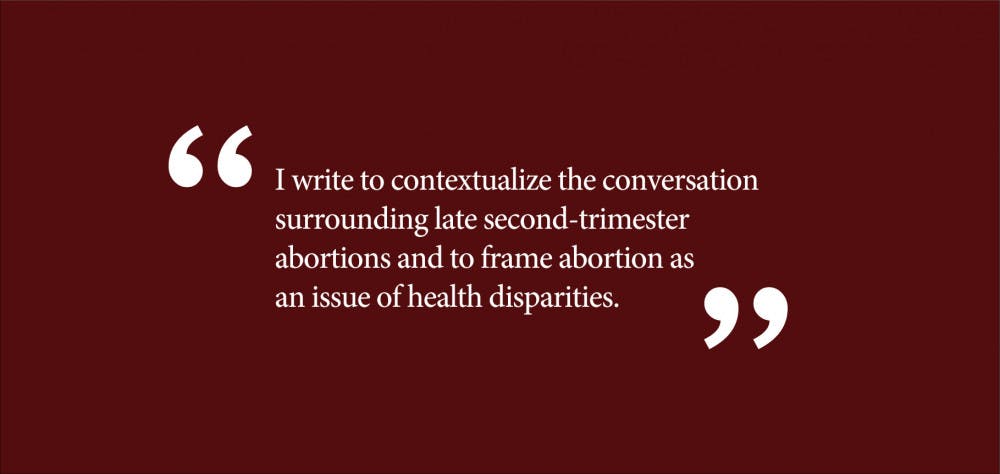In his April 10 piece “Reconfiguring abortion rights in the era of technology,” Jay Khurana ’18.5 writes: “Most of us agree that in the vast majority of cases … it would be wrong to abort a third-trimester fetus. However, why should we feel any differently about a fetus in its third trimester than we do a fetus late into the second?”
“For students who are pro-choice,” he writes, “it is especially important to engage with these ideas instead of dismissing them.” As a pro-choice, Master of Public Health candidate, I am here to respectfully engage with the portion of his argument questioning late second-trimester abortions.
I am not writing this piece to argue the morality of abortion. I know all too well from working at Planned Parenthood and testifying at the State House that many anti-choice individuals in this country believe abortion is murder. Rather, I write to contextualize the conversation surrounding late second-trimester abortions and to frame abortion as an issue of health disparities.
I recently finished my master’s thesis about Rhode Island’s declining abortion rate. For this project, I was provided data for all legal, recorded abortions performed in Rhode Island between 2012 and 2016. Of the 14,778 abortions in my data set, there are only 56 abortions at 21 weeks, 29 abortions at 22 weeks and one abortion at the 23-week mark — and nothing beyond that. For reference, the second trimester of gestation consists of weeks 13 to 28. The rarity of later abortions in my Rhode Island dataset parallels national data. The CDC Abortion Surveillance System reported that only 1.3 percent of abortions in 2015 were performed at or after 21 weeks. Perhaps Khurana and pro-life individuals can then understand my frustration when so much of the controversy surrounding abortion (especially in the media) is about later abortion care.
The data does not say why these womxn had an abortion at 21, 22 or 23 weeks. Regardless, it is not my place to judge that individual’s decision. Perhaps it was a congenital anomaly. Perhaps the patient’s life was in danger. Perhaps it was the stigma from family, friends or the community. Or, perhaps it was the cost of the procedure or other barriers that prevented these womxn from receiving earlier abortion care.
In 2014, 49 percent of abortion patients in the United States lived below the federal poverty level, and 75 percent of abortion patients that year qualified as low-income. As the cost of a first-trimester abortion is approximately $500 and the price only increases after that point, it may take many of these womxn months to afford any sort of procedure. I would like us all to take a moment to recognize the immense privilege that comes with having $500 or more readily accessible.
Bear with me as I pose a hypothetical situation — though undoubtedly a situation many womxn have faced. A woman in Mississippi, a state with only one abortion clinic, finds out she is eight weeks pregnant: an unintended, unwanted pregnancy. This woman already has two young children at home — not surprising since the majority of abortion patients already have children. She thought nothing of a “late” period due to the irregularity of her menstrual cycle. She works 10-hours a day at a minimum wage job at $7.25/hour. She has no savings and it takes her seven weeks to raise the $500 to cover the abortion, while still paying for rent, utilities and food for her family. By the time she has the money, she can no longer get an abortion in her home state because Mississippi recently passed legislation to ban abortion in some cases as early as six weeks. She then has to raise the funds to travel to another state, expenses which include childcare, missed work, housing and travel accommodations. For me, it is easy to understand why womxn may have to have abortions after the first trimester.
All of this is to say two things. First, later abortion is incredibly rare compared to the total number of abortions. Second, womxn most likely do not wake up in the middle of their second trimester and think “I do not want to be pregnant anymore.” Perhaps either something has gone horribly wrong in a pregnancy, or they’ve been trying to raise funds for the often insurmountable barrier of cost.
Khurana calls on us — the Brown, pro-choice community — to be more compassionate toward individuals with views different from our own. I would flip that narrative to ask the anti-choice community to first acknowledge the rarity of later abortions, show compassion toward individuals that have to make the (sometimes) difficult decision to get an abortion and attempt to understand the expenses, stigma and stress that come with that decision. Challenging the right to a second trimester abortion challenges the right to abortion, as Khurana notes through Supreme Court cases. Challenge my right and I guarantee an evidence-based response.
Isabel Blalock ’18 GS studies the public health implications of abortion access and can be reached at isabel_blalock@brown.edu. Please send responses to this opinion to letters@browndailyherald.com and op-eds to opinions@browndailyherald.com.





